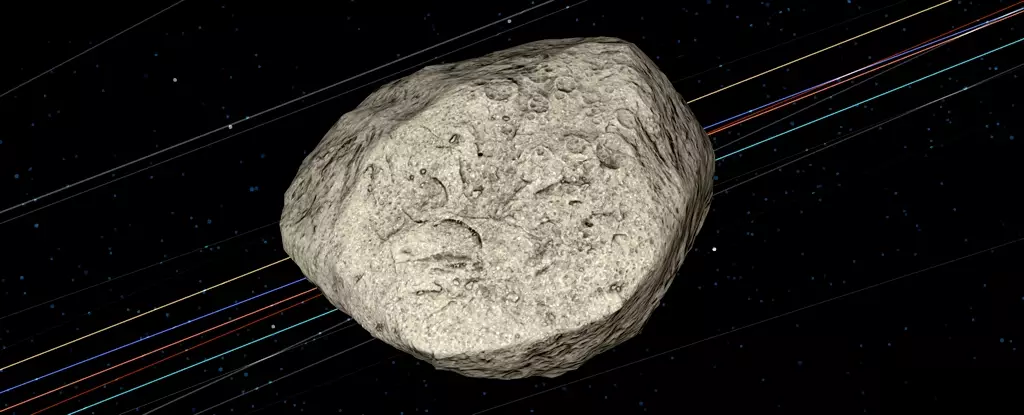In the realm of astronomy, few events are as thrilling as the close pass of an asteroid, particularly one as intriguing as 99942 Apophis. Named after the ancient Egyptian deity symbolizing chaos and darkness, this asteroid is poised for a near-Earth encounter in April 2029. While the initial fear surrounding its potential collision with our planet has long been assuaged, this upcoming flyby presents scientists with a unique opportunity to investigate the dynamics of near-Earth objects (NEOs) and how they interact with our planet’s gravitational influence.
The Shift in Perception: From Threat to Opportunity
When Apophis was first observed in 2004, charts of its trajectory painted a cause for concern, suggesting a possible collision with Earth. As data accumulated and error margins were refined, it became clear that this fear was unfounded; the asteroid will pass safely within about 32,000 kilometers (20,000 miles) of our planet. However, the true value of the 99942 Apophis flyby lies not in the fear of potential catastrophe, but rather in the insights it can offer about the nature of asteroids and the forces at play during close planetary encounters.
The Scientific Enigma of Asteroid Surfaces
Asteroids like 99942 Apophis possess surfaces that should, by all rights, show extensive wear given their eons of exposure to the harsh environment of space. Yet, unexpectedly, many NEOs display geological features that appear comparatively young. This contradiction raises questions about their history and the impacts they have endured. Ronald Ballouz, a planetary scientist, alongside his team at Johns Hopkins University Applied Physics Laboratory, hypothesized that gravitational interactions with Earth might be responsible for refreshing the chaotic surfaces of these asteroids.
To examine this hypothesis, Ballouz’s team engaged in sophisticated modeling of the Apophis flyby. The asteroid’s structure is still somewhat a mystery, though data suggests it could be bi-lobed—a configuration akin to the irregularly-shaped 25143 Itokawa. The researchers utilized Itokawa’s traits as a template, manipulating variables to simulate how Apophis would behave when subjected to Earth’s gravitational forces.
The initial results indicate that as Apophis approaches Earth, it will undergo intense tremors. These seismic activities, likely to shake loose the asteroid’s surface components, could disrupt the loosely aggregated material that forms its exterior. The seismic waves produced might even be measurable from Earth, providing researchers with real-time data on the effects of our planet’s gravity on celestial bodies.
The longer-term implications of this encounter are equally fascinating. Beyond merely shaking things up, the gravitational pull from Earth could alter Apophis’s rotational speed. As it maneuvers through our planet’s gravitational field, changes in spin could lead to a gradual redistribution of material on its surface over tens of thousands of years. This phenomenon could explain the relatively youthful appearance of some NEOs as they “refresh” their surfaces, potentially counteracting the slow degradation typically expected in asteroids.
Research has established that a flyby can have significant effects on an asteroid’s spin state, particularly when the approach distance is within 16 Earth radii (approximately 102,000 kilometers). With Apophis set to come much closer than this threshold, the potential for surface alteration becomes a tantalizing possibility.
The Importance of Observation: A Rare Window of Opportunity
While the scientific community eagerly anticipates the 2029 flyby, there’s a palpable excitement surrounding the opportunity for direct observation. The asteroid will be bright enough to see with the naked eye, which is rare for celestial bodies of this nature. This presents researchers with an unparalleled chance to gather substantial data and undertake further studies concerning the structure and composition of Apophis.
Such observations are vital, not only for advancing our understanding of asteroids overall but also for providing insights into the early solar system’s history—the building materials from which our planet and its neighbors were composed. Understanding Apophis could, therefore, illuminate our knowledge of planetary formation and evolution.
As the countdown to 2029 continues, the scientific community stands poised on the brink of discovery. Asteroid 99942 Apophis may not be an immediate threat to our planet, but the geological secrets it hides could transform our comprehension of celestial bodies in our solar neighborhood. While we prepare to embrace the cosmic visitor, it serves as a reminder of our inherent connection to the universe and the ever-present mysteries that await our understanding.


Leave a Reply